For most of November, I was on my honeymoon in Spain and Portugal. Thanks to my incessant graphomania, you get to see my attempt at a travel journal as I journeyed from Porto down to Lisbon, into Spain by way of Seville, up the eastern coast, into Barcelona. Cathedrals. Narrow, winding streets. Historical episodes trivialized. The first and second in the series can be read here and here and here. Also, if you haven’t subscribed or upgraded to a paid subscription, do it now.
XVII.
We were staying near the Catedral de Sevilla, so we shouldn’t have been surprised. We had drinks at a small cafe, and were walking back to the hotel. A lot of people seemed to be wearing suits or formal dresses, but this is one of the more conservative parts of Spain, and there were plenty of commercial districts nearby.
Passing by the cathedral, the crowds got thicker. They were watching a line of young men in suits carrying large walking sticks with candles at the end of them. Most of them had a haunted look in their eyes, glazed but somehow determined.
I was uncomfortable. Mrs. Daydream was just curious. Using her rusty Spanish (still better than mine), she asked someone passing by. “Excuse me, sir. What is this procession?” He looked at her like she had asked what continent we were on.
“It’s a procession,” he answered.
“Yes, but what for?”
He spoke slower. “It’s… a… procession.”
The idea of a procession being for a procession was certainly novel. Also depressingly nihilistic. It had the ring of a practice whose origin had been obscured by the millennia but no one dared stop. No meaning, no resonance, no poignancy. Just the inertia of ritual for ritual’s sake. Why do we do this? We do this because we do this.
She did her best to clarify. Finally, either feeling sorry for these poor curious souls or simply wanting to get the hell away from us, he did his best to answer. “The procession… is for Jesus.”
It was an underwhelming answer. This was clearly a Catholic procession. Just about everything they do is for Jesus, but normally it goes through one of a whole constellation of saints, martyrs, and apostles. One of the reasons I’ve always been puzzled by the stark division between monotheism and polytheism. Isn’t it all one? And isn’t that one so multifaceted?
As it turns out, the frustrated passerby was only half correct. We turned and saw a massive canopied platform, again carried by a few dozen young men, adorned with lit candles and a large Virgin Mary figure in the center. It was stunning. It was awe-inspiring. It was also terrifying, for reasons I couldn’t fully articulate.
Back at the hotel, the scenes on TV provided a better explanation. Inside the cathedral, hundreds of beefy men vaulted themselves over each other, completely indifferent to injury or to damaging their Sunday best, all to get a chance at touching the figure of the Virgin Mary. Pulling, pushing, climbing, occasionally throwing punches just to get a single foot closer.
From what I could tell, nobody was doing anything to allow for cooler heads. To suggest a nice orderly line so that everyone could get a chance to show their devotion and be blessed by Jesus’ mom. I felt like I was watching scenes from the Hillsborough Disaster. Only this time it wasn’t people panicking beneath the weight of the human crush, but eagerly participating. This wasn’t a scene of mass devotion. It was a scene of unbridled frenzy: a crowd of individuals showing dangerous indifference to others’ safety to be most blessed.
Only at the end of the news segment did it become clear that this footage was from a different procession, in a different part of Andalusia. From the sound of it, it is easy to confuse them. We learned the next day that Seville has more Catholic processions than any other city in Spain. During Holy Week, in the lead-up to Easter, there are often several a day. Organizers and city planners do their best to ensure their routes don’t collide, but it is frequently futile. Scenes of iron-faced church members, some in elaborate costumes, entangled at corners and intersections, unsure which direction to go, fearing that if they guess incorrectly they’ll wind up at the wrong destination. I wondered if brawls ever broke out in these situations, like they did on the TV.
XVIII.
Spain’s reputation is often that of a crazed Catholic nation, but the fact is that only about 50 percent of the country identifies as part of the faith, with only about a third of them identifying as practicing. Percentage-wise, there are more Spanish atheists and agnostics than there are devoted Catholics.
Still, that 50 percent stands, in part, thanks to a rather unsavory past. During the Franco years, the Church worked hand-in-glove with the regime to strengthen its legitimacy, and Catholicism was the preeminent spiritual force in public life. Which isn’t to say that every practicing Catholic was happy with the level of political and cultural repression in Spain. Far from it. The Catalan, Galician, and Basque languages were legally banned from being spoken in public. Predictably, any opponent of fascism – be they anarchist, communist, liberal, or nationalist, and no matter what faith – was imprisoned, and often executed.
Forty years of this kind of governance can warp memory quickly. Under Franco, the Spanish Inquisition – hundreds of years of forced conversion and medieval torture – was viewed as a positive, a necessary purge of heretics and dissenters to preserve Spain’s cultural purity. It even produced its own form of denialism, roughly akin to the kind we’ve increasingly seen around the Holocaust in recent decades. According to some thinkers, including those with jobs at serious academic institutions, the Inquisition is nothing more than a “black legend” perpetuated by nefarious Protestants to defame Catholic Spain.
Seville holds a notable place in the history of the Spanish Inquisition. It was here in 1481 that Spain’s first auto-da-fé took place. Twelve men and women were accused of practicing Judaism, and burned at the stake. We say “accused of practicing Judaism” because by that time there was for the most part no real way to pick out a Jew in public. The phenomenon of the converso already existed by this point: Jews who had, willingly or otherwise, converted to Catholicism. There was always the possibility of practicing in private, though, and many did.
In 1391, ninety years before the first auto-da-fé, with the Black Plague slithering its way across the continent, residents of Seville and other Spanish towns rampaged through their Jewish Quarters, massacring Jews left and right. In Seville, the pogroms were aided by the architecture. In 1248, after Ferdinand III seized the city from the Muslim Almoravid dynasty, Jews were moved into what became the Juderia, right next to the palace. Many affluent Jews aided in trade and money-lending, and the nobility wanted them easily accessible.
Only a few small entrances allowed entry into the area. Any army trying to invade the Jewish Quarter would be slowed, as they would by the narrow, winding streets. During the 1391 massacre, these defenses turned the Juderia into a death trap for its residents. Four thousand Jews were killed.
XIX.
You can see the various layers of history in Seville. It’s well known that before all this was Andalusia, it was Al-Andalus, passing through a succession of Islamic dynasties. Prior to that it was briefly ruled by the Visigoths and Vandals. Before them, it was a Roman province, and before that, it was the Phoenecians. When entering an old enough building, you step down from the doorway of one epoch onto the floor of another. The Catedral de Sevilla started as a mosque. It took a few hundred years to be completed and added onto. You can see Islamic, Gothic, and Renaissance eras on its facade.
Not all these layers so graciously make way for each other. Case in point: there is almost nothing Jewish remaining in the Juderia. After the massacre of 1391, any Jews left were now publicly Christian, though many continued to practice their culture and spirituality behind closed doors. This Jewish Quarter came to be known as Santa Cruz.
In fact, there’s very few of anyone living in the area. According to our tour guide, most of the homes there are empty, often rented out as AirBnB’s. Every building there is protected by the Spanish government, but from the sound of it, they are only periodically occupied by affluent globetrotters who want to pretend they are living in the Old World. Residency in the area is so sparse that local schools are trying to convince people who work nearby to send their kids there. If that doesn’t work, the schools will likely close.
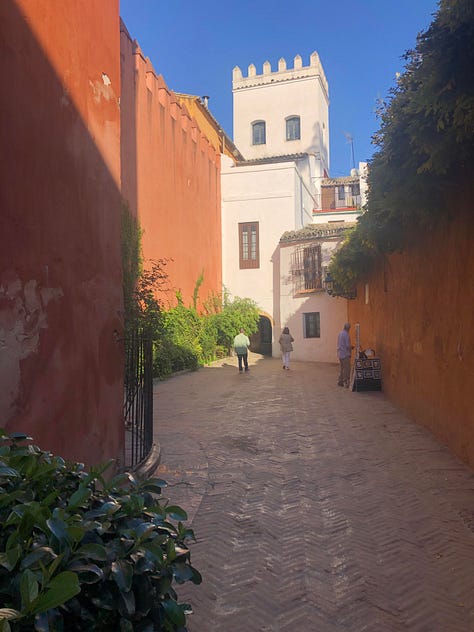
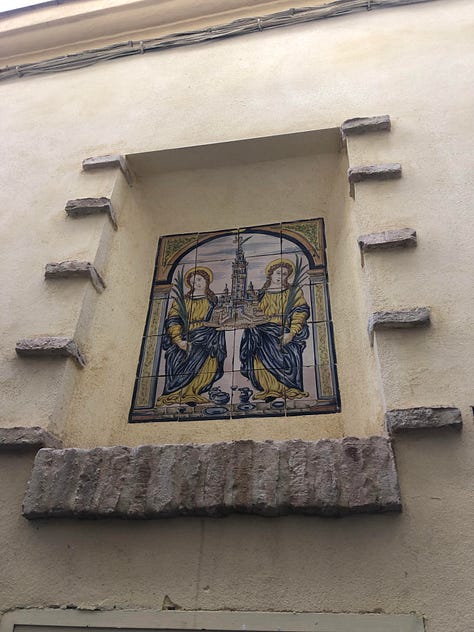
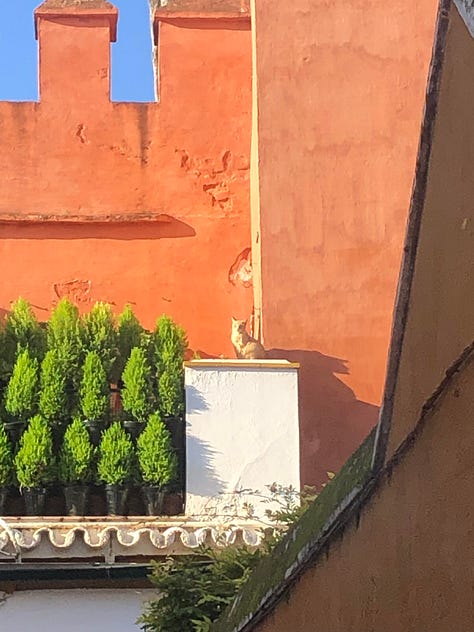
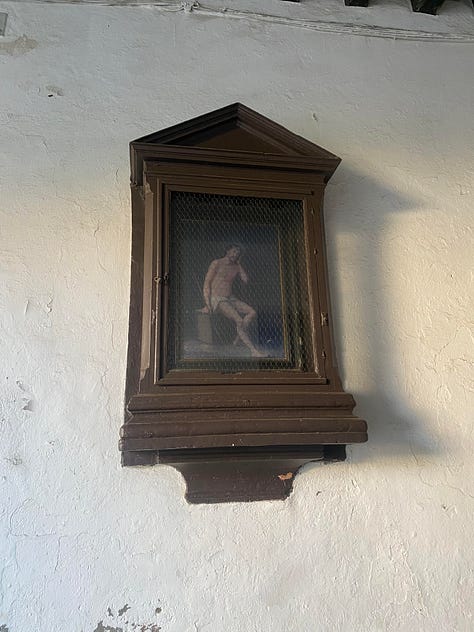
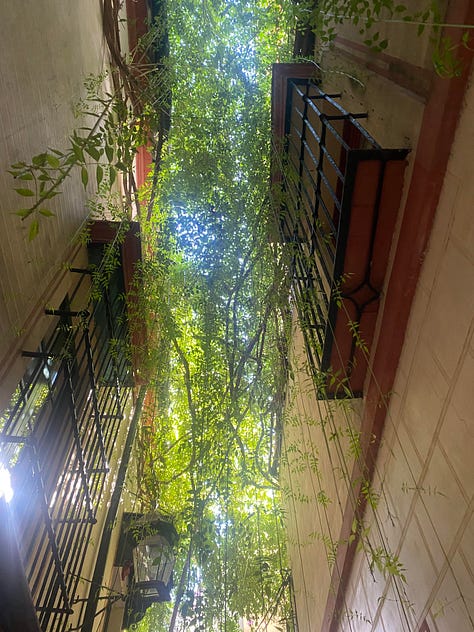
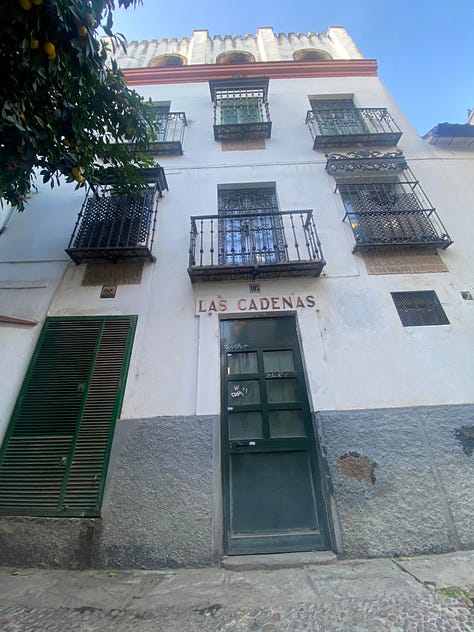
In Santa Cruz, the synagogues have been converted into churches. Frequently, our guide would point to a crucifix or a fresco of the Virgin Mary, and say that there probably used to be a Jewish symbol of some kind; a hamsa or Magen David. It was about this time that this song popped into my head. It stayed there for the duration of our time in Seville:
There is one reminder of the Juderia that stands out, but it is rather cryptic, and in more than one sense. At the corner of Calle Agua and Calle Vida, over the door of one of the apartment buildings, there is a tile painted with the image of a human skull. The skull belongs to a young woman named Susona, and the legend goes that this was once her house.
She came from a prosperous converso family, and was engaged to a young Christian whose father was of the nobility. In 1480, one year before the first auto-da-fé in Seville, her father Don Diego got word that the Church was looking to root out the conversos that still held on to their Jewish faith and practices. In other words, the Inquisition was in the air.
Don Diego did the sensible thing. He convened a secret meeting of other converso patriarchs to discuss the possibility of an armed uprising against the Christians. Susona overheard the details of this meeting, however, and it made her fear for her betrothed. So she told him. He told his father, who had Don Diego and his co-conspirators arrested. They were tried and executed.
Susona, overwhelmed with grief, retreated to a convent. She spent the rest of her life there. After she died, she had her skull hung over the front door of her house as a reminder: don’t trust the Christians. The skull hung for more than a hundred years, rotting and festering. Eventually, it was switched out for the tile.
XX.
Listening to this recounted, underneath this very tile, I found myself shook. Or at least I should have. I was not born Jewish. I converted as an adult. Some people say that makes me “less of a Jew.” True, I don’t keep kosher, and I have no truck with the state of Israel. But I’ve argued my case in front of a panel of rabbis, and they agree I’m a Jew, so take it up with them. Before that, I was Catholic, though like many other Catholics around the world (especially those who identify as communists) I was long lapsed. I’d gone through communion and first confession and confirmation and after that, all the things I’d been taught suddenly felt like more of a threat than anything like what I might call an ontological grounding. Every ceremony and ritual, every mass and prayer, felt like a bulldozer.
The legend of Susona is chilling. It’s got all the emotional makings of a great tragedy. Romance. Heartbreak. Betrayal. Deep and conflicting familial ties. Death. Self-exile. It’s dramatic, operatic even, and it was adapted into an opera that premiered in Spain earlier this year. I haven’t seen that opera, but if it’s any good then I’d imagine it makes you feel the flawed humanness of all involved, whether you in the audience are Jewish, Catholic, atheist, or Muslim. We are all, without exception, marched through time by inertias masquerading as “who we are.” That’s the tragedy, and it’s universal. Some would say that a person with my specific history should be particularly touched by it.
Should is once again the key word here. But as this legend was being told to us, I couldn’t stop the melodic refrains of Mel Brooks and company rattling in my brain. The Inquisition (Let's begin!) / The Inquisition (Look out, sin!) / We have a mission / To convert the Jews (Jew-jew-jew-jew-jew-jew-jews)...
XXI.
Only later was I struck with the contrast between the muted impact of the legend of Susona and the profundity of what I felt watching the candlelit dreadnought of the Virgin Mary coming towards us the night before. Maybe it was just my sick sense of humor hitching a ride on invasive thoughts. Maybe Brooks just knows how to write one hell of an earworm. Or maybe it was that everything and everyone seemed so damn nonchalant about what had taken place in the Juderia. This was the site of a full-on pogrom: beheadings, disembowelings, mass rapes, skulls caved in, throats and chests ripped open, thousands killed in front of their own children before the children were also slaughtered. It was a human erasure in the most literal and extreme sense.
What exactly is the cut-off point for telling jokes about a tragedy? I make Holocaust jokes; it became my sacred right after I converted. The past few years have seen us finally lighten up about 9/11. Jokes can be mean-spirited and nasty and serve the purpose of a veiled threat. They can also be a way of relieving tension around something unhealed.
There is a difference between a joke, however, and not taking something seriously. You might say we make jokes about tragedies because we feel the wounds left by them. Because the human brain is always looking for a way to make sense of the senseless and contradictory.
No, this nonchalance made it seem like these stories, these pogroms and mass executions, occurred in only the most abstract way. It wasn’t necessarily in the tone of our tour guide. The built environment itself failed to remember, like it was under airtight glass of some kind. Save for the small skull tile and the occasional sign reading Juderia, there was little indication of what had once been here. Even the process of abstraction — the decision to cover up with only the most cursory acknowledgment of that decision — is a decision in itself, and also goes unacknowledged.
Why it was made is subject to speculation. Was it for the comfort of the last few residents in Santa Cruz? Or for the tourists? It is difficult to imagine people wanting to holiday on a site that feels the ghosts of its crimes so unmistakably, let alone live there. In any case, for as narrow and overshaded and quiet as these roads were, they felt unbound by the horrible things that had been done on them.
Here’s the rub. When the history of a place is flattened, so is your personality within it. You’re let off the hook from asking where you fit into it. What you would have done. What you would do now. All the cracks and fissures and stitched together experiences that make you you are dulled and smoothed. And you become unbearably light, in all the senses Kundera meant it. You, the tumultuous events of past and future, none of them matter.
Most everywhere else on this peninsula, you can feel time surrounding you. Part of it is anchored by the people who live on it. They know what happened, so we do too. Here, though, in what used to be the Juderia and is now known as Santa Cruz, where nobody lives but everything is preserved, it feels like an entertainment. The story of Susona’s skull may as well have been a sequence on the Haunted Mansion ride.
XXII.
Seville’s Juderia is hardly unique in this respect. In every place humans have existed in modernity’s longue duree, people, cultures, and histories are displaced. Just across the Guadalqivir River in Seville is the Triana neighborhood. Historically, it’s been populated by potters, sailors, construction workers, and Flamenco dancers. Today, you’ll find none of the above. There’s a smattering of Flamenco performers, but they’re here mainly for the tourists. Few, if any, live nearby. The large Romani population that used to be here was driven out during the neighborhood’s redevelopment in the 1970s. Riverside apartments are just too expensive for most people who work for a living.
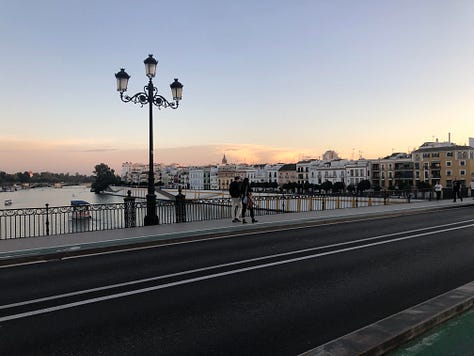
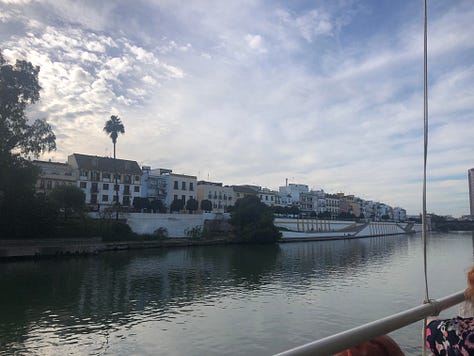
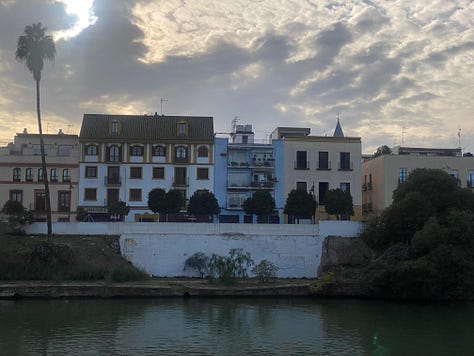
You can probably guess what remains after that redevelopment. The aesthetic, the look and feel of the salty, vaguely gritty neighborhood, familiar with hard labor, remains intact. It meshes well with the haute riverside restaurants, which is to say it doesn’t mesh at all. In the area around Santa Cruz, you step from the Kingdom of Castile into the Umayyad Caliphate. In Triana, you step out from the cold, clean angularity of the early 2000’s onto the earthy cobblestones that someone from the early 2000’s thinks look like a pre-war barrio.
It doesn’t strike with quite the same drama – you’re still conscious something has happened, is happening here – but it’s made from the same stuff as the Inquisition Disneyland. Say what you will about those willing to throw hands to touch an effigy, at least they are acting out an actual, genuine moment. Which is more than you can say for some people in Triana. Unlike most of the Anglo-American world, Spain’s middle class hasn’t fully escaped the trappings of hipsterism. There are plenty of checked shirts and clunky workboots and knit fishermen’s caps here. I’m sure they cost more than anyone should reasonably pay. You can feel history thinning out here, its consequence disintegrating, rendered unburdensome and frivolous. And people seem willing to act their part in it. The only thing separating Triana from Santa Cruz is that in Santa Cruz the process has had more time to work itself out.
There are places in Seville where this dreadful telos gets tangled and confused. And as we all know, tangled and confused is the best thing that can happen to an urban environment. The Setas de Sevilla are ugly as sin, like most postmodern architectural sculptures. A street market once stood on this spot, but the last of it shuttered in the ‘70s. The land sat undeveloped until 1990, when the city started digging to build an underground parking lot. Roman and Islamic ruins were discovered, and construction halted.
The decision was made in 2004 to open up a competition for a structure to be built on the site. This is what won. Because architecture is full of losers. It has six “parasols” spreading up into the sky and convening into one large platform. Its honeycombs are made from wood, and the Setas are promoted by the city as the largest wholly wooden structure in the world. Locals affectionately refer to them as “the mushrooms.”
Underneath, the ancient antiquarium is perfectly preserved. And in between, at the base of the Setas, a few cafes and shops. Some of them are shuttered permanently, driven out by high rents. Those remaining try to keep up the pretense of trendiness, but are inevitably undermined by the grime and litter scattered everywhere, the dirty pigeons and their shit.
From the top platforms, you can see the chaos of Seville is more of this same. Everything is utterly mismatched, feebly attempting to create a greater whole and dismally succeeding. I loved it. Accidentally or on purpose, it lets the time periods collide and mutate into each other. It makes the city look like what it is: improvised. If big and important architects can improvise a city, why can’t anyone with a sense of imagination?
XXIII.
It’s not supposed to rain in Andalusia, at least not this time of year. Before the deluge that hit two weeks before we arrived, it hadn’t rained since June. The damage was minimal in Seville. It was worse in other parts of Andalusia, far worse up the coast in Valencia. As the storm closed in on the peninsula, Prime Minister Pedro Sánchez called the Valencian provincial president Carlos Mazón to offer humanitarian and evacuation assistance. Mazón, a member of the conservative People’s Party, whose provincial administration is supported by the far-right Vox Party, dismissed the offer. The storms and the floods they caused swept away more than 200 people. Thousands more were left homeless.
In the days after, 130,000 Valencians demonstrated, many of them still without a livable home, demanding Mazón’s resignation. Trying to contain the crowd, police brutalized protesters, many of whom fought back. In his closing remarks at the Historical Materialism conference in London, Andreas Malm called this “the first climate riot in Europe,” and indeed the first in what we call the Developed World.
As climate change warps weather patterns, making them more volatile and unpredictable, some truly heinous questions about who gets to live where will follow. We only need to look to New Orleans for a sense of what that looks like. It’s been almost 20 years since Hurricane Katrina. Bourbon Street is still there, catering to out-of-towners’ ideas of what Bourbon Street “should” be. The Lower Ninth Ward, its decades and centuries of roots weaving between homes and catacombs, is infested with condos and corporate headquarters.
A more immediate example may come out of Gaza. Brochures with plans for beachside properties were being drafted by the time the first bombs began to fall. National Security Minister Ben Gvir is wailing at rallies about the need to “resettle” Gaza. Whether it’s human-made or natural, disaster can get you some great real estate.
In both examples, note that there is a faultline between who “deserves” to come back and who doesn’t. So it was in the Juderia. There is also an unstated hope that with enough time, with enough people tiring of talking about it, all the ruptures and traumas will cease mattering, letting history drift through its own ether.
Will some come back? Certainly. History is full of conversos of one kind or another. Some choose it, believing they are better for it. Some do it because they want to be part of the attraction. Some do it because they think it will help keep their heads down, hoping those marching through the town’s center won’t single them out. Because, in the words of Torquemada, it’s better to lose your skullcap than your skull.
All photos are by Kelsey Goldberg and the author.









